
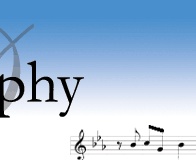

![]()
LET'S FALL IN LOVE - ANYA TARANDA
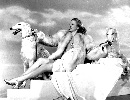 During his work on Earl Carroll's Vanities in 1932, Harold Arlen
met celebrated Powers model, Anya Taranda, who, barely in her mid-teens,
was a member of the show's cast. All that the striking blonde model had
to do was stand around in approved Earl Carroll fashion, but with her
beauty, that was enough.
During his work on Earl Carroll's Vanities in 1932, Harold Arlen
met celebrated Powers model, Anya Taranda, who, barely in her mid-teens,
was a member of the show's cast. All that the striking blonde model had
to do was stand around in approved Earl Carroll fashion, but with her
beauty, that was enough.
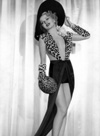 Harold
was instantly taken with Anya, but was much too shy to do anything about
it. After much time, he finally worked up the courage to invite her to
his apartment for dinner one night. Unfortunately, he became so nervous
about having her over that he started to panic and, in order to cope with
the situation, invited another friend to dinner as well. Though the dinner
was not as intimate as Harold had hoped, it did begin what turned into
a grand love affair between the two.
Harold
was instantly taken with Anya, but was much too shy to do anything about
it. After much time, he finally worked up the courage to invite her to
his apartment for dinner one night. Unfortunately, he became so nervous
about having her over that he started to panic and, in order to cope with
the situation, invited another friend to dinner as well. Though the dinner
was not as intimate as Harold had hoped, it did begin what turned into
a grand love affair between the two.
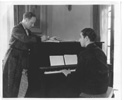 Once
the spark of romance had been struck between them, Harold and Anya were
rarely apart. Even when their busy careers forced them to be apart, they
would find a way to be together, even if it meant only being able to talk
on the phone. Unfortunately, when Harold went to California in 1933 with
Ted Koehler for one month to work on songs for the screen play Let's
Fall in Love, his cross-country calls to Anya quickly added up.
Anxious not to be apart from his love for too long, he quickly hurried
back to New York as soon as his five weeks work on the film were up.
Once
the spark of romance had been struck between them, Harold and Anya were
rarely apart. Even when their busy careers forced them to be apart, they
would find a way to be together, even if it meant only being able to talk
on the phone. Unfortunately, when Harold went to California in 1933 with
Ted Koehler for one month to work on songs for the screen play Let's
Fall in Love, his cross-country calls to Anya quickly added up.
Anxious not to be apart from his love for too long, he quickly hurried
back to New York as soon as his five weeks work on the film were up.
Despite his consumption with Anya, Harold remained busy at work. In 1934 Yip Harburg asked him to collaborate on a show in New York to be produced by the Shuberts and Harburg's co-lyricist Ira Gershwin. At the time, Anya was in California working on the film Murder at the Vanities. Harold was not exactly anxious to be away from Anya, but he was excited to collaborate with such fine men to do a Shubert Revue and, therefore, accepted the offer.
Harold's longtime friend and former roommate, Ray Bolger, costarred in the Revue with comedian Bert Lahr. Soon other fine talents were signed as well. Happily for Harold, as soon as Anya Taranda returned from her film chores, she too was signed. The bulk of the work for the Revue was done at Ira Gershwin's apartment, which was directly across the street from the building where brother George Gershwin lived. Together, Arlen, Harburg and Gershwin worked to write the score of Life Begins at 8:40.
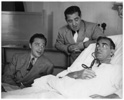 In
1935, Harold went back to California after being signed by Samuel Goldwyn
to write songs for the film Strike Me Pink starring Eddie Cantor
and old friend, Ethel Merman. Evidently, Anya was also signed to appear
in the film. Not surprisingly, Harold's frequent visits to the Goldwyn
lot had more to do with Anya's presence than it did with his interest
in the progress of the film.
In
1935, Harold went back to California after being signed by Samuel Goldwyn
to write songs for the film Strike Me Pink starring Eddie Cantor
and old friend, Ethel Merman. Evidently, Anya was also signed to appear
in the film. Not surprisingly, Harold's frequent visits to the Goldwyn
lot had more to do with Anya's presence than it did with his interest
in the progress of the film.
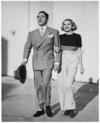 Once
his work on Strike Me Pink was completed, Harold took up partnership
with Yip Harburg once again and signed a yearlong contract with Warner
Brothers. Before starting the score they were hired to compose, the two
decided to finish a song Harold had begun writing some time before while
back in New York. That song was Last Night When We Were Young.
Once
his work on Strike Me Pink was completed, Harold took up partnership
with Yip Harburg once again and signed a yearlong contract with Warner
Brothers. Before starting the score they were hired to compose, the two
decided to finish a song Harold had begun writing some time before while
back in New York. That song was Last Night When We Were Young.
Arlen and Harburg wrote three musicals for Warner Brothers, none of which made film history. In 1936 Arlen and Harburg wrote Song of the Woodman for a Broadway Revue called The Show Is On. It opened on Christmas Day, 1936, and became a hit. Not long after, Arlen returned to New York to see the show, accompanied by Ms. Anya Taranda.
One evening as Harold said his good-bye to Anya at her door, he handed her a note that read: "Dearest Anya - We're getting married tomorrow - 'bout time don't you think? All my love, H." Ironically, almost five years of hard thinking resulted in this seemingly spontaneous note. Contrary to how it appears, Harold had not made up his mind to marry Anya on the spur of the moment. The only thing that kept Harold from asking her to marry him sooner was his parents.
Some months earlier, while Harold was visiting his parents in Syracuse, Cantor Arluck unexpectedly brought up the subject of Harold's relationship with Anya Taranda. Cantor Arluck was very concerned about his son's involvement with her because of the difference in their religions - he was Jewish and she was Catholic. Despite Cantor Arluck's concerns, Harold assured his father that he knew what he was doing. For Harold, the difference in their religions, and his parents' concern about such, could not change his undivided love for Anya.
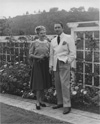 Having
read the note that Harold gave her that fateful night, Anya actually showed
up the next day for the two to be wed. The marriage was gracefully accepted
by all parents concerned and the subject of Anya's religion was never
brought up again by Cantor Arluck. Anya was warmly welcomed into the Arluck
family, as was Harold into the Taranda family. Once married, the newlyweds
said farewell to New York and moved to California, where they lived for
many years.
Having
read the note that Harold gave her that fateful night, Anya actually showed
up the next day for the two to be wed. The marriage was gracefully accepted
by all parents concerned and the subject of Anya's religion was never
brought up again by Cantor Arluck. Anya was warmly welcomed into the Arluck
family, as was Harold into the Taranda family. Once married, the newlyweds
said farewell to New York and moved to California, where they lived for
many years.
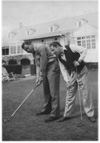 Finally
together, Harold and Anya Arlen had time to relax and enjoy a highly active
social life as part of Hollywood's elite. They'd often spend afternoons
at the Gershwins' and evenings playing cards at the Kerns'. They'd play
tennis with Dorothy Fields and Moss Hart and go out at
Finally
together, Harold and Anya Arlen had time to relax and enjoy a highly active
social life as part of Hollywood's elite. They'd often spend afternoons
at the Gershwins' and evenings playing cards at the Kerns'. They'd play
tennis with Dorothy Fields and Moss Hart and go out at 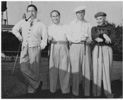 night
with the Berlins. And of course, one should note the many hours Harold
spent on the country club golf course with friends Ira Gershwin, Ray Bolger,
Groucho and Harpo Marx, Jack Benny, George Burns, Jerome Kern, Danny Kaye,
Danny Thomas, Joe Lewis and others. The Arlens were living the high life
- things were simply magical.
night
with the Berlins. And of course, one should note the many hours Harold
spent on the country club golf course with friends Ira Gershwin, Ray Bolger,
Groucho and Harpo Marx, Jack Benny, George Burns, Jerome Kern, Danny Kaye,
Danny Thomas, Joe Lewis and others. The Arlens were living the high life
- things were simply magical.
Harold and pal E.Y. Harburg returned to New York in 1937 to write the score for a show produced by the Shuberts called Hooray for What? It was during their work on this show that long-time friend George Gershwin died after an unsuccessful attempt to remove a tumor in his brain. Arlen and Harburg, deeply affected by this loss, sadly continued their work as best as possible. The show met with several delays in opening for various reasons. However, as soon as it was finally (and successfully) launched, they returned to Beverly Hills. At that time. Metro-Goldwyn-Meyer was looking around for the right composer for a special project it was working on. Little did Harold know that he would soon be working on the score for a film that would mark the pinnacle of his career - The Wizard of Oz!
< Previous | Top | Next >